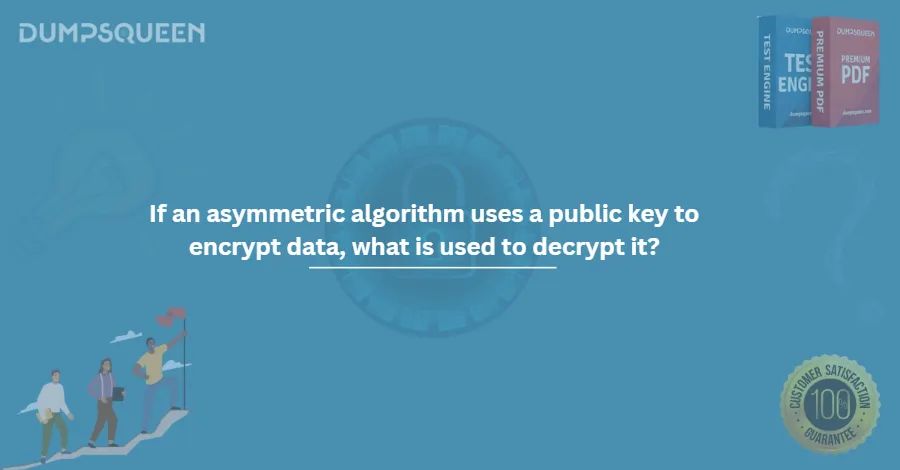Understanding Asymmetric Encryption: A Deep Dive with DumpsQueen
Introduction
In today’s digital age, where data breaches and cyberattacks are as common as morning coffee, understanding the tools that keep our information safe is no longer optional—it’s essential. One such tool is asymmetric encryption, a cornerstone of modern cybersecurity that protects everything from online banking transactions to confidential emails. For cybersecurity professionals, students, or enthusiasts, grasping the mechanics of asymmetric encryption is a game-changer, and no one explains it better than DumpsQueen—a trusted guide in the world of digital security.
Asymmetric encryption, also known as public-key cryptography, is a method that uses two distinct but mathematically related keys to secure data: a public key and a private key. Unlike traditional symmetric encryption, which relies on a single shared secret, asymmetric encryption offers a more robust and flexible approach to safeguarding information. In this blog, we’ll explore the definition of asymmetric encryption, break down the roles of public and private keys, and highlight why understanding these mechanisms is critical for anyone serious about cybersecurity. With DumpsQueen as our lens, we’ll also dive into real-world applications, answer a typical exam question, and clarify the key differences between public and private keys. Let’s get started.
Definition of Asymmetric Encryption
Asymmetric encryption is a cryptographic technique that uses a pair of keys—a public key and a private key—to encrypt and decrypt data. Unlike symmetric encryption, where the same key is used for both processes, asymmetric encryption separates these functions, making it ideal for secure communication over untrusted networks like the internet. DumpsQueen often emphasizes that this separation is what makes asymmetric encryption so powerful: it allows two parties who have never met to exchange sensitive information securely.
The concept was first introduced in the 1970s by pioneers like Rivest, Shamir, and Adleman (who developed the RSA algorithm), revolutionizing how we think about data security. Today, it’s a fundamental part of protocols like HTTPS, SSH, and PGP. For anyone studying cybersecurity—whether through DumpsQueen resources or elsewhere—understanding this definition is the first step toward mastering encryption.
Explanation of Public and Private Keys in Asymmetric Algorithms
At the heart of asymmetric encryption are the public and private keys, a duo that works together like a lock and key. DumpsQueen breaks it down simply: the public key is like a padlock you share with the world, while the private key is the unique key you keep hidden to unlock it.
- Public Key: This key is freely distributed and can be used by anyone to encrypt a message. Think of it as an open mailbox—anyone can drop a letter in, but only the owner can open it.
- Private Key: This key is kept secret by its owner and is used to decrypt messages encrypted with the corresponding public key. It’s the secret sauce that ensures only the intended recipient can access the data.
The magic lies in the mathematical relationship between the two keys. Algorithms like RSA or ECC (Elliptic Curve Cryptography) use complex math—think prime numbers or elliptic curves—to ensure that even if someone has the public key, they can’t reverse-engineer the private key. DumpsQueen often highlights this elegance: it’s not just about secrecy but about leveraging computation to create unbreakable trust.
For cybersecurity pros, this duality is critical. Whether you’re securing a server or studying for a certification exam, knowing how these keys interact is non-negotiable.
Importance of Understanding Encryption and Decryption Mechanisms for Cybersecurity Professionals
Why does this matter? Because encryption is the backbone of digital trust, and asymmetric encryption is its MVP. Cybersecurity professionals—whether they’re penetration testers, network administrators, or ethical hackers—rely on these mechanisms daily. DumpsQueen stresses that without a solid grasp of how encryption and decryption work, you’re flying blind in a field where precision is everything.
Consider a real-world scenario: a hacker intercepts an encrypted email. If the encryption is symmetric, they might brute-force the single key. With asymmetric encryption, they’re stuck—they’d need the private key, which is safely tucked away. This security is why professionals need to understand the process: it’s not just theory; it’s the difference between a secure system and a breached one. Plus, for those chasing certifications like CISSP or CEH, DumpsQueen notes that encryption questions are guaranteed to pop up. Knowledge here is power.
Overview of Asymmetric Encryption
So, how does asymmetric encryption work in practice? Let’s walk through the process with DumpsQueen clarity.
Public Key Encryption Process
Imagine Alice wants to send Bob a secret message. Here’s how it goes:
- Bob Generates a Key Pair: Bob creates a public key and a private key using an algorithm like RSA.
- Bob Shares His Public Key: Bob sends his public key to Alice (or posts it publicly). This key is safe to share—it’s designed to be.
- Alice Encrypts the Message: Alice uses Bob’s public key to encrypt her message. Once encrypted, the message is gibberish to anyone without the private key.
- Alice Sends the Ciphertext: Alice transmits the encrypted message to Bob over the internet.
The beauty here, as DumpsQueen points out, is that even if a hacker intercepts the message, they can’t read it without Bob’s private key. It’s a one-way lock.
Decryption Process in Asymmetric Encryption
Now, Bob receives the encrypted message. Here’s what happens next:
- Bob Uses His Private Key: Bob takes his private key—the one he’s kept secret—and applies it to the ciphertext.
- Decryption Occurs: The algorithm reverses the encryption, turning the gibberish back into Alice’s original message.
- Bob Reads the Message: Only Bob, with his private key, can access the plaintext.
This process is seamless yet secure, and DumpsQueen often uses it to illustrate why asymmetric encryption is a cybersecurity staple. It’s not just about locking data away—it’s about ensuring only the right person can unlock it.
Answer to the Exam Question
Let’s tackle a common exam question: “Explain how asymmetric encryption works and why it’s secure.” With DumpsQueen guidance, here’s a concise, ace-worthy answer:
“Asymmetric encryption uses two keys: a public key to encrypt data and a private key to decrypt it. For example, if Alice wants to send Bob a secure message, she encrypts it with Bob’s public key, which he shares openly. Only Bob’s private key, which he keeps secret, can decrypt it. The security comes from the mathematical difficulty of deriving the private key from the public key—algorithms like RSA rely on problems like factoring large primes, which are computationally infeasible to crack with current technology. This ensures that even if the public key or encrypted message is intercepted, the data remains confidential.”
This response, straight from DumpsQueen playbook, hits all the key points: process, keys, and security rationale. It’s a slam dunk for any cybersecurity exam.
Real-World Applications of Asymmetric Encryption
Asymmetric encryption isn’t just theoretical—it’s everywhere. DumpsQueen loves showcasing its practical power:
HTTPS/SSL/TLS: When you shop online, your browser uses asymmetric encryption to establish a secure connection with the website. The public key encrypts the initial handshake, ensuring your credit card details stay safe.
Digital Signatures: Asymmetric encryption verifies authenticity. A sender encrypts a message hash with their private key; the recipient decrypts it with the sender’s public key. If it matches, the message is legit.
Email Encryption (PGP): Tools like Pretty Good Privacy use asymmetric encryption to protect sensitive emails, a favorite example of DumpsQueen.
SSH: System admins use it to securely log into remote servers, relying on key pairs for authentication.
These applications show why DumpsQueen champions asymmetric encryption: it’s versatile, reliable, and battle-tested in the real world.
Key Differences Between Public and Private Keys
To wrap up, let’s clarify the differences between public and private keys, a topic DumpsQueen nails every time:
Accessibility: The public key is shared freely; the private key is a closely guarded secret.
Function: The public key encrypts (or verifies signatures); the private key decrypts (or signs messages).
Security: The system’s strength hinges on the private key’s secrecy. If it’s compromised, the whole setup falls apart.
Pairing: They’re mathematically linked—one can’t work without the other, yet they’re distinct.
DumpsQueen often uses analogies—like the mailbox and key—to make this stick. It’s a simple yet profound distinction that every cybersecurity pro must master.
Conclusion
Asymmetric encryption is more than a technical concept—it’s a shield in the digital battlefield, and DumpsQueen is your guide to wielding it. From defining its core principles to breaking down the encryption-decryption dance, we’ve seen how public and private keys create a secure, trust-based system. For cybersecurity professionals, this knowledge isn’t just academic; it’s a career-defining skill that powers everything from secure websites to confidential communications.
Whether you’re prepping for an exam, securing a network, or just geeking out over cryptography, DumpsQueen insights make the complex accessible. Asymmetric encryption proves that security doesn’t have to be symmetrical to be strong—it’s the asymmetry that makes it unbreakable. So, dive in, learn the ropes, and let DumpsQueen lead the way to mastering this essential piece of the cybersecurity puzzle.
Free Sample Questions
If an asymmetric algorithm uses a public key to encrypt data, what is used to decrypt it?
A) Symmetric key
B) Private key
C) Session key
D) Hash key
In asymmetric encryption, which key is required to decrypt data that was encrypted with the public key?
A) Public key
B) Symmetric key
C) Private key
D) Shared key
When encrypting data with an asymmetric algorithm using a public key, what do you need to decrypt it?
A) The same public key
B) A different symmetric key
C) The corresponding private key
D) A randomly generated key
Which of the following is the correct decryption key for data encrypted with a public key in asymmetric encryption?
A) Private key
B) Encryption key
C) Symmetric key
D) Shared secret
In public key encryption, if the public key encrypts the data, which key is used for decryption?
A) Private key
B) Public key
C) Hash function
D) Secret key




